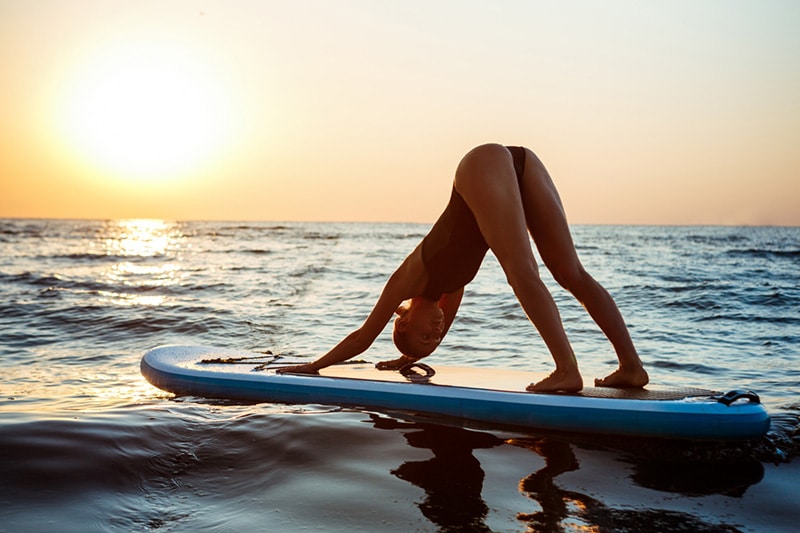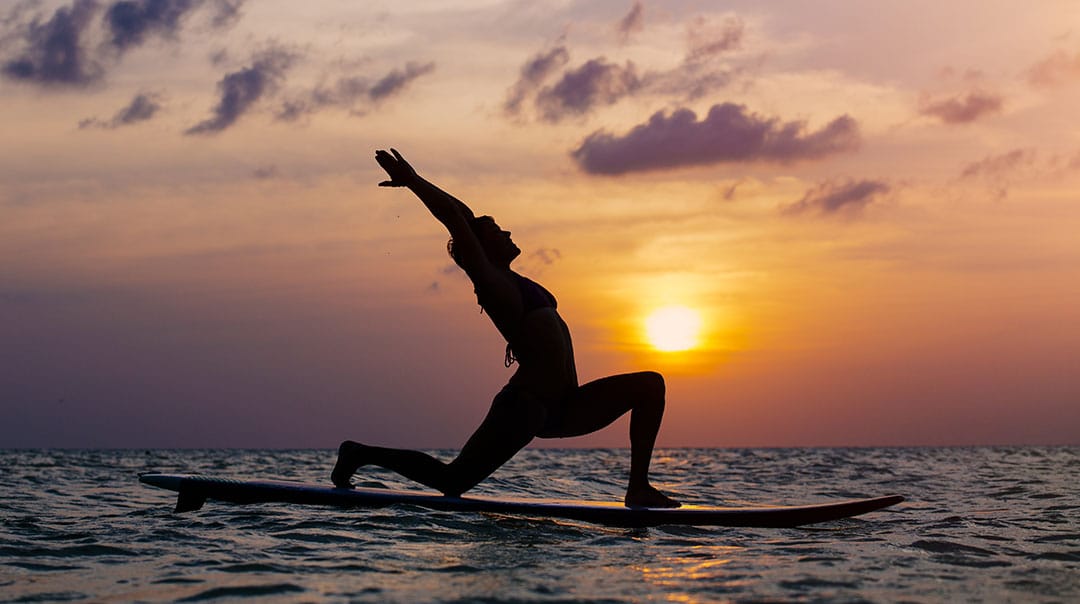Have you tried traditional yoga practice and want to explore another form of it?
On water? Well, SUP yoga may be just the thing for you.
SUP yoga involves practicing similar poses that you use on land.
But on a stand up paddle board.
It’s an excellent way to build strength and relax your mind.
What’s more, if you lose your balance and fall, you’ll just end up taking a refreshing plunge into the water!
Sound good? Have a read through our guide on SUP yoga poses, and before you know it, you’ll be stretching out on the open waves.
The Best Paddle Boards For Practicing Yoga

When it comes to choosing the best stand up paddle board for SUP yoga, there are a lot of options available.
Generally, inflatable paddle boards tend to be the best.
As they provide more give than a hard board, they help prevent feet and legs from becoming sore while practicing your SUP yoga poses.
They’re also a lot easier to transport than a hard board because they deflate down to the size of a sleeping bag.
- 3 YEAR MANUFACTURERS WARRANTY
- Roc’s Paddle Boards are now made with the highest-grade material that is 50% stronger than competitors boards. Find out why Roc is the top-rated paddle board sold on Amazon and around the world.
- With an industry leading 350lbs weight limit. You can see why Roc is committed to manufacturing the safest most reliable paddle board on the market.
- Our extra wide design creates an incredible all-around board for all skill levels. Making it the perfect board for all.
Last update on 2024-11-21 at 03:54 / Affiliate disclosure / Images & pricing from Amazon Product Advertising API
However, if you do choose a hard board, as long as it’s wide enough and stays stable on the water while you’re posing on it, then this will also be fine for SUP yoga.
Top 10 Stand Up Paddle Board Yoga Poses
There are many different SUP yoga poses for you to learn, and over time you’ll figure out a SUP yoga sequence that’s ideal for you.
To get you started, we’ve laid out ten of the best beginner and intermediate yoga poses for you to try out on your stand up paddle board.
1. Downward Facing Dog
Technique
First, get down on all fours. Stretch your arms out straight in front of you.
Keep your hands shoulder-width apart with your palms flat against the board.
Now, push your toes firmly down into the board and gradually raise your hips so that your knees are straight.
Bend your knees a little if you’re struggling.
Your wrists might begin to hurt, and if so, make a fist or use your fingertips instead.
Keep your hips up and your tailbone pointing up into the air. Maintain this position.

Effects
This pose is great for your back and will lead to the strengthening of the arm and shoulder muscles.
It’ll also give your legs a thorough stretch, right up from the soles of your feet to your hamstrings.
2. Crescent Lunge
Technique
Begin on all fours on your paddle board.
Position one leg with your foot flat on the board and your knee at a 90-degree angle.
Stretch your other leg straight out behind you. Keep your hands firmly on the board to balance yourself as you adopt this yoga pose.
When you’re steady, gradually stretch your hands out in front of you and then slowly move them upwards.
Try and bring your palms together. Maintain this position for a while, then repeat the yoga pose with the other leg.
Effects
The crescent lunge pose stretches your hips and legs and through repetition, will strengthen your arm, leg, and glute muscles.
It will also open up your chest and shoulders.
This is one of the best SUP yoga poses for practicing balance on the water.
3. Plank Pose
Technique
Start on all fours. Stretch your legs out straight behind you.
Push your toes into the paddle board and point your heels upwards.
If you can, try twisting your hips from side to side.
Effects
This is one of the most beneficial SUP yoga poses for strengthening your core and toning your abs.
It will also give you greater strength in your legs and arms.
4. Upward Facing Dog
Technique
For this SUP yoga pose, begin by lying on your stomach on your paddle board.
Bring your hands back towards you so that they’re underneath your shoulders.
Slowly bring your torso up and straighten your arms. As you do this, move your elbows in towards your abdomen.
Keep your knees and legs straight and flat against the paddle board.
Effects
This SUP yoga pose is also known as the cobra pose, as your body shape resembles a snake.
It helps to make your spine more flexible and your back muscles stronger. Your shoulders and torso should also be well stretched.
5. Boat Pose
Technique
Begin this SUP yoga pose in a seated position on your paddle board, with your arms down at your sides.
Keeping them hip distance apart from each other, slowly raise your feet until your toes are level with the top of your head.
As you do this, raise your arms so that they’re pointing straight ahead with your thumbs towards the sky.
Effects
The boat pose is great for strengthening your core and will also give your legs a good stretch.
It also helps to improve your balance on the paddle board.
6. Seated Prayer Pose
Technique
Begin by sitting down on your board and crossing your legs in front of you.
Your back should be straight with your head upright, looking straight ahead.
You can either bring your palms together in a praying position in front of your chest or rest them on your knees.
Focussing only on your breathing, let your body relax and slowly let the tension release from your body.
Effects
This SUP yoga pose is not only relaxing for your body, but is also therapeutic for your mind.
It’s one of the easier SUP yoga poses and should be restful.
7. Tree Pose
Technique
For this SUP yoga pose, you need to stand in the center of your paddle board.
Keep either your left foot or your right foot slightly behind or in front of the board’s handle.
Your hands should be stretched out to your sides.
Now raise one of your feet off the board and balance. Rest the sole of this foot against the ankle of your standing foot.
Keeping your balance, try moving the sole of your foot further up the other leg to the knee.
Bring your palms together into a praying position.
Effects
The tree pose is one of the best SUP yoga poses for improving your balance.
It will also tone your leg muscles and give them more strength.
8. Child’s Pose
Technique
Begin down on all fours, and then push your bottom up while arching your back.
Your arms must stay straight, and you should then push back your hips so that your bottom comes to rest on your heels.
Now, move your hands forward and bring your forehead down to touch the board, with your torso against your thighs.
Effects
The child’s pose is one of the most relaxing SUP yoga poses for the body and the mind.
A lot of people like to use this pose to rest in between other more challenging poses. It’s also good for digestion and your abdomen.
9. Chair Pose
Technique
Start by standing in the middle of your paddle board with your feet apart.
Stretch your arms out in front of you with your hands pointed upwards slightly.
Now bring your hips gradually down into a sitting position.
If you struggle to balance while performing this pose, you can try widening the distance between your feet.
If you want to make it more difficult, bring your feet closer together.
Effects
The chair pose is one of the most beneficial SUP yoga poses for strengthening your core and legs.
It’s also great for your ankles and back.
10. Malasana Pose
Technique
Stand up straight with the board’s center handle in between your feet.
Move your toes so that they’re pointing outwards, and point your heels inwards.
Gradually bring your hips down towards the board.
Keeping your back straight, bring your palms together into a praying position.
Effects
This SUP yoga pose strengthens your ankles, knees, and legs. It will also stretch out your groin and lower back very nicely.
Some instructors recommend this pose to pregnant women, as it’s good for the abdomen.
SUP Yoga Classes

You can practice these yoga poses on your own or with friends, but you may want to consider taking SUP yoga classes with a certified yoga instructor.
Many instructors offer single sessions of paddle board yoga instruction for beginners and also courses that will last for several weeks.
Taking classes is a good way for you to develop a SUP yoga routine that matches your ability and that will give you the maximum benefits.
You could even sign up for yoga retreats if you’re really serious about honing your SUP yoga skills.
You might find that you enjoy it so much that you want to train to become a SUP yoga guru yourself!
Final Thoughts
SUP yoga really is for everyone. From those wanting a new, relaxing pastime to those who want to truly test the limits of their body.
Once you’ve got the right paddle board, you can get out into the water and try out some of the yoga poses we’ve detailed for you in this guide.
So, if you’re ready, paddle out and get posing!

